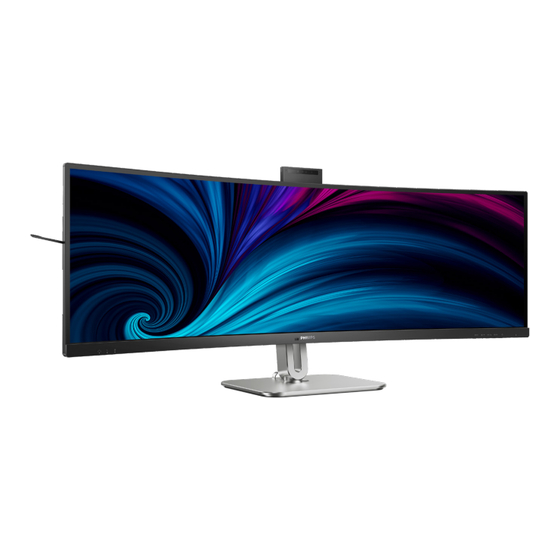
Summarization of Contents
1. Important Product Information
1.1 Safety Precautions and Maintenance
Guidelines for safe operation, handling, and upkeep of the monitor to prevent hazards.
1.2 Notational Descriptions
Explains document symbols and text conventions like Notes, Cautions, and Warnings.
1.3 Product Disposal Guidelines
Instructions for environmentally responsible disposal of the monitor and packaging.
2. Monitor Setup and Operation
2.1 Installation and Connections
Steps for unpacking, assembling the stand, and connecting the monitor to a PC.
2.2 Operating Controls and OSD Menu
Details on monitor buttons, OSD navigation, and customization options.
2.3 Webcam and Communication Features
Setup and use of the built-in webcam, autoframing, busylight, and hook button.
2.4 MultiClient KVM and Noise Cancelling
Using KVM for multi-PC control and noise cancelling for clear audio.
2.5 MultiView and VESA Mounting
How to use MultiView for picture-in-picture and how to remove the base for VESA mounting.
3. Display Optimization and Connectivity
3.1 Image Optimization Modes
Using SmartImage, SmartContrast, and LightSensor to enhance picture quality.
3.2 HDR Settings
Guide to configuring HDR settings in Windows 11/10 for vibrant visuals.
3.3 Thunderbolt Docking and Daisy-Chaining
Connecting via Thunderbolt for docking and linking multiple monitors.
3.4 Power Management and Ergonomics
Energy saving with PowerSensor and tips to prevent eye strain.
3.5 Adaptive Sync Technology
Explanation of Adaptive Sync for smoother gaming performance.
4. Technical Specifications
4.1 Display and Connectivity Specs
Details on display panel, inputs, outputs, and connectors.
4.2 USB, Power, and Convenience Specs
Specifications for USB ports, power consumption, and user convenience features.
4.3 Physical, Environmental, and Resolution Specs
Dimensions, weight, operating conditions, resolution, and format compatibility.
4.4 Power Management Definition
Explanation of VESA DPM compliance and power saving modes.
5. Product Support
5.1 Pixel Defect Policy
Philips policy defining acceptable levels of pixel and sub-pixel defects.
5.2 Customer Care and Warranty
Information on Philips support, warranty policies, and service.
5.3 Troubleshooting and FAQs
Solutions for common monitor issues and answers to frequently asked questions.















Need help?
Do you have a question about the SuperWide 49B2U6903CH and is the answer not in the manual?
Questions and answers